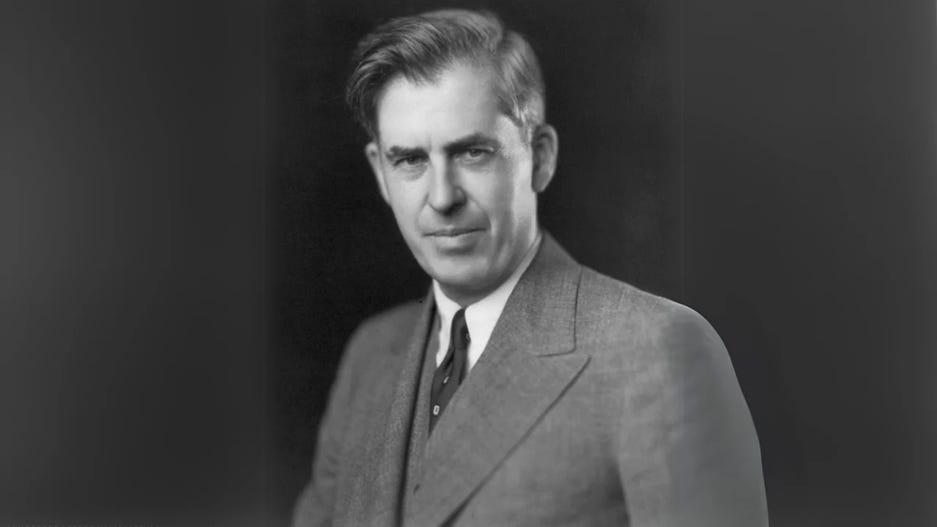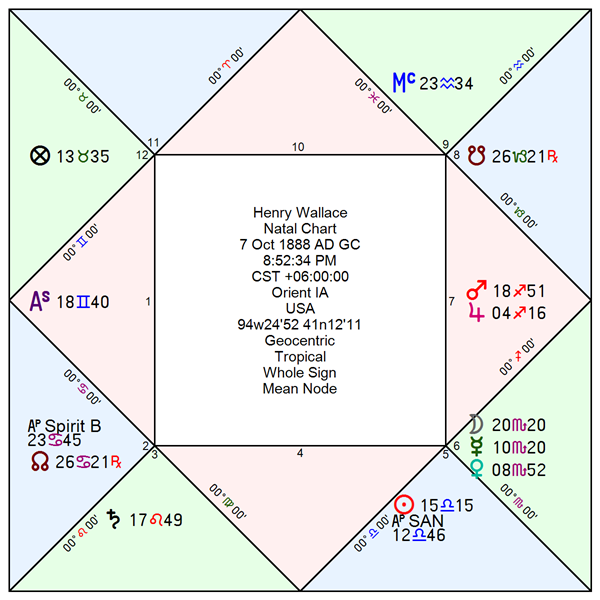Last week’s natal database entry featured William Jennings Bryan, the most well-known American politician with Jupiter in Cancer in his natal horoscope. Bryan was nicknamed the “Great Commoner” for his political populism. After Bryan, Henry Wallace occupied a similar position on the populist political spectrum. He rose to political power through his expertise in farming, earning his role as Secretary of Agriculture under the FDR administration, following in the footsteps of his father, who had held the same post. Like Bryan, Wallace’s horoscope signature for political populism is Jupiter in Cancer. Unlike Bryan, whose Jupiter is placed directly in Cancer, Wallace’s Lot of Spirit is placed in the bound of Jupiter in Cancer. My research demonstrates that the bound position of either the Lot of Fortune or the Lot of Spirit adds a comparable influence to the native’s life, as if the horoscope contained the same planet/sign combination as the bound placement of the Lot.
Henry A. Wallace was an American politician, agricultural expert, and progressive visionary who served as the 33rd Vice President of the United States (1941–1945) under President Franklin D. Roosevelt. Born on October 7, 1888, near Orient, Iowa, Wallace was raised in a family steeped in agricultural science and public service; his father, Henry C. Wallace, served as Secretary of Agriculture. After graduating from Iowa State College in 1910, Wallace became a leading agricultural innovator, publishing extensively on crop science and launching Wallace’s Farmer, a prominent farm journal.
In 1926, Wallace founded the Hi-Bred Corn Company, which would become Pioneer Hi-Bred, revolutionizing American agriculture through hybrid seed corn. His expertise brought him into government service when Roosevelt appointed him Secretary of Agriculture (1933–1940) during the New Deal. Wallace implemented transformative programs such as the Agricultural Adjustment Act, stabilizing farm prices during the Great Depression and introducing soil conservation measures.
A committed internationalist and advocate of economic democracy, Wallace was nominated as Vice President in 1940 for Roosevelt’s third term. His tenure (1941–1945) was marked by outspoken advocacy for racial equality, labor rights, and global cooperation. His famous 1942 speech, “The Century of the Common Man,” called for worldwide social and economic justice, distinguishing him as one of the most progressive voices of his era. Wallace envisioned a postwar order grounded in shared prosperity and equality, in sharp contrast to Henry Luce’s 1941 essay, “The American Century,” which promoted U.S. global dominance, capitalist expansion, and the spread of American influence abroad. Where Luce’s vision celebrated American exceptionalism, Wallace emphasized democratic inclusion and the uplift of all nations, underscoring the ideological divide between liberal internationalism and imperial ambition during World War II.
Wallace’s relationship with Roosevelt was largely supportive, but tensions emerged within the administration—most notably with Jesse Jones, head of the Reconstruction Finance Corporation. Wallace clashed with Jones over the administration of wartime economic aid, particularly concerning Wallace’s support for developmental investments in rubber plantations in the Amazon to reduce U.S. dependence on Southeast Asian sources. Wallace proposed an ambitious plan for industrial development in Latin America, rooted in his belief in hemispheric cooperation and modernization, but Jones resisted diverting RFC funds and accused Wallace of overstepping his role. The conflict became a bitter internal struggle that exposed deeper ideological rifts between New Deal liberals like Wallace and conservative business figures like Jones.
After losing the vice presidency to Harry Truman in 1944, Wallace served as Secretary of Commerce (1945–1946) before breaking with the Truman administration over Cold War policies. In 1948, he ran for president as the Progressive Party candidate, campaigning against segregation, militarism, and nuclear escalation. Though he received less than 3% of the vote, his campaign reflected a strong left-liberal current in postwar America.
Wallace was also known for his interest in spirituality, mysticism, and esoteric ideas—corresponding with thinkers such as Nicholas Roerich and consulting astrologer L. Edward Johndro during the 1930s. In later years, Wallace focused on farming and writing. He died on November 18, 1965, in Danbury, Connecticut.
Today, Wallace is remembered as a visionary reformer and controversial idealist—a man who sought to align science, social progress, and global peace at a critical juncture in American history.
ADB Rodden Rating A, From memory, 7:30 PM, ASC 25TA06
Proposed rectification (2020), 8:52:33 PM, ASC 18GE40'14"
Rectification details available in excel workbook (Paid subscriber member benefit). As this rectification varies substantially from the reported birth time, it is recommended that students test events vs the rectified horoscope, especially transits of Jupiter and Saturn to the angles, as one method of verification. In reviewing my rectification for this post, I found the transit of Jupiter, then Saturn, to the Ascendant degree helpful in timing the peak and trough of his political career under the FDR administration.
Victor Model factors favoring Jupiter/Sagittarius
Bound lord of Sun, Moon, and Lot of Spirit. Valens says when the same planet is the bound ruler of both luminaries to look no further for the victor
Angular in the 7th house
Essential dignities: sign, nocturnal triplicity, bound, and decan
Physigonomy model factors Gemini
Long face
Thin long nose
Moon’s Configuration: Moon separates from Saturn and applies to Jupiter
The aspect sequence is as follows:
1. Moon in Scorpio: separates from the square of Saturn
2. Void-of-course: Moon is void until 23SC46 when its 10° 30′ application to Jupiter activates
3. Moon in Sagittarius: applies to the conjunction of Jupiter in an out-of-sign aspect.
Phase 1: Moon Square Saturn (Leo, 3rd house/quadrant; 4th house/whole signs)
Symbolism: Saturn in Leo, positioned in the 4th whole sign house, symbolizes conflict around authority, homeland, and inherited power structures. The Moon’s square aspect (in-sign) reflects a tense departure from those frameworks.
Biographical Match: Wallace’s separation from Saturn embodies both emancipation and struggle. Drought and agricultural failure during the Dust Bowl marked his tenure as Secretary of Agriculture. Though he introduced innovations like crop rotation and soil conservation, Saturn’s influence showed up as continued hardship connected to land and national resources. Bureaucratic opposition — such as from Jesse Jones — functioned as Saturnian resistance from conservative institutional figures.
Phase 2: Void-of-Course Moon
Biographical Match: Henry Wallace’s battles with Jesse Jones during 1943 were a major reason why Wallace was dropped as FDR’s Vice Presidential candidate at the 1944 DNC. Conflict with the Truman administration over his willingness to engage peacefully with Russia at the beginning of the Cold War led President Truman to ask for Wallace’s resignation as Commerce Secretary. Common to both of these events was conflict with conservatives which led to career dead-ends. This led to a brief career lull between December 1946 and December 1947 when Wallace announced a third party bid for the 1948 Presidential election.
Phase 3: Moon Applies to Jupiter (Sagittarius, 7th house)
Symbolism: Moon’s application to Jupiter in the mutable sign of Sagittarius means an increase in growth on at the personal level (philosophy, religion), at the business level (agriculture), and at the political level (global outreach, diplomacy, economic growth). There is a scattershot approach: many arrows thrown, some hit, others miss.
Biographical Match: Wallace’s global agricultural programs, including the hybrid corn revolution he helped create, were eventually realized after he left the national stage. He remained spiritually open throughout life, embracing theosophy, anthroposophy, astrology, and Eastern religions. His Progressive Party platform of 1948 championed civil rights, economic justice, and peace.
Influence of Sect
Figure is nocturnal which degrades the Moon’s configuration. Saturn: intensifies the harshness of political conservatives who opposed Wallace’s political career. Jupiter: Wallace’s proposals for wartime rubber plantations in South America with a developmental economic edge were out-of-synch with conservatives like Jesse Jones. His dalliances with alternate religions, astrology, and quirky individuals were out-of-step with mainstream America, limiting the appeal of his spiritual pursuits. Conservatives thought Wallace was a freak.
AI Notice: ChatGPT contributed to this article.
Keep reading with a 7-day free trial
Subscribe to House of Wisdom to keep reading this post and get 7 days of free access to the full post archives.



